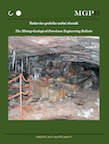Metal waste management and recycling methods in the nuclear power plant decommissioning and dismantling process
DOI:
https://doi.org/10.17794/rgn.2018.1.4Abstract
Decommissioning and dismantlement of nuclear power plants (NPP) present a final phase of the nuclear power plant lifetime and essential part of an effective nuclear safety culture. While some countries are implementing nuclear exit strategies and other building new nuclear power plants or prolonging their lifetimes, decommissioning of facilities is imminent. This paper gives a short overview on decommissioning and dismantling strategies and techniques as an introduction to the applicability of radioactive metal waste recycling and reuse. General estimations suggest that majority of the waste mass resulting from decommissioning and dismantling is radiologically unrestricted material. Remaining one-third is the radioactive material with different ranges of radioactivity. To present radioactive metal scrap recycling in practice, paper addresses estimations on metal waste amounts resulting from decommissioning, use of melting as a possible recycling method (with regard to secondary waste generated) and aspects of environmental and health impacts. Additionally, a best practice example of decommissioning process in a pressurized water reactor (PWR) technology NPP is given to provide context for possible future decommissioning of NPP Krško. After consideration of available data on decommissioning waste management, the conclusion is that while the decision on decommissioning strategies and technologies is not straightforward but unique to each country, current experiences give important context to complexity and potential of decommissioning and provide a basis for future actions.
Keywords: nuclear power plants, decommissioning and dismantling, metal recycling, waste management
Downloads
Published
How to Cite
Issue
Section
License
Copyright (c) 2017 Rudarsko-geološko-naftni zbornik

This work is licensed under a Creative Commons Attribution 4.0 International License.
Creative Commons-BY
Authors who publish with this journal agree to the following terms:
In agreeing this form, you certify that:
- You read the ethical codex of the RGN zbornik available at journal web.
- You submitted work is your original work, and has not previously been published and does not include any form of plagiarism.
- You own copyright in the submitted work, and are therefore permitted to assign the licence to publish to RGN zbornik.
- Your submitted work contains no violation of any existing copyright or other third party right or any material of an obscene, libellous or otherwise unlawful nature.
- You have obtained permission for and acknowledged the source of any illustrations, diagrams or other material included in the work of which you are not the copyright owner.
- You have taken due care to ensure the accuracy of the work, and that, to the best of your knowledge, there are no false statements made within it.
- All co-authors of this submitted work are aware of, and in agreement with, the terms of this licence and that the submitted manuscript has been approved by these authors.
Publication licence
You retain copyright in your submitted work, according to journal license policy (CC-BY). By signing this form you agree that RGN zbornik may publish it under the publication licence. In summary the licence allows the following:
Anyone is free:
- To copy, distribute, display, and perform the work.
- To make derivative works.
Under the following conditions:
- The original author must always be given credit.
- The work may not be used for commercial purposes.
- If the work is altered, transformed, or built upon, the resulting work may only be distributed under a licence identical to this one.
Exceptions to the licence
In addition to publishing the work printed under the above licence, RGN zbornik will also enable the work to be visible online.
The journal editorial can change the licence rules anytime but it cannot retroactively restrict author(s) rights.


